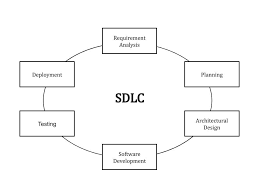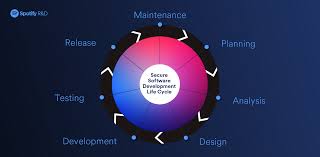The Software Development Life Cycle (SDLC) is a crucial framework followed by software engineers to ensure the successful development and delivery of high-quality software products. It encompasses a series of well-defined phases that guide the entire software development process from inception to deployment.
The first phase of the SDLC is the Requirements Gathering phase, where software engineers work closely with stakeholders to understand their needs and gather detailed requirements. This involves conducting interviews, workshops, and analyzing existing systems to identify what functionalities the software should possess.
Once the requirements are gathered, the next phase is System Design. Here, software engineers create a blueprint for the software system, defining its architecture, data structures, modules, and interfaces. The design phase helps in visualizing how different components will interact with each other and ensures that all requirements are addressed effectively.
After the design is finalized, it’s time for Implementation or Coding. In this phase, programmers write code based on the design specifications using programming languages like Java, C++, or Python. They follow coding standards and best practices to ensure maintainability and readability of the code.
The completed code then undergoes rigorous testing in the Testing phase. Quality Assurance (QA) engineers perform various types of testing such as unit testing, integration testing, system testing, and acceptance testing to identify defects or bugs. This helps in ensuring that the software meets all functional and non-functional requirements.
Once all defects are fixed and the software passes all tests successfully, it moves into Deployment or Release phase. Here, software engineers deploy the application on production servers or distribute it to end-users through app stores or other distribution channels. They also provide necessary documentation and user guides for smooth adoption of the software.
After deployment comes Maintenance phase where any issues reported by users are addressed promptly through bug fixes or updates. Regular maintenance ensures that the software remains stable and secure throughout its lifecycle.
The SDLC provides a structured approach to software development by dividing it into manageable phases. It helps in minimizing risks and ensures that the software is developed efficiently, meeting both client requirements and industry standards.
Adhering to the SDLC also promotes collaboration among team members, as they follow a shared framework and clearly defined roles and responsibilities. This leads to better coordination, improved communication, and ultimately results in successful software development projects.
In conclusion, the Software Development Life Cycle (SDLC) is a comprehensive framework that guides software engineers through every stage of the development process. By following this well-defined approach, software engineers can deliver high-quality software products that meet client expectations while adhering to industry standards.
6 Essential Tips for Successful SDLC in Software Engineering
- Define clear project requirements
- Plan and design effectively
- Break down tasks into manageable units
- Adopt an iterative approach
- Conduct thorough testing
- Document rigorously
Define clear project requirements
Defining clear project requirements is a crucial tip in the Software Development Life Cycle (SDLC) for software engineering. It lays the foundation for successful software development by ensuring that all stakeholders have a shared understanding of what needs to be achieved.
When project requirements are not clearly defined, it can lead to misunderstandings, scope creep, and ultimately, project failure. Ambiguous or incomplete requirements can cause delays, cost overruns, and result in a product that does not meet the intended purpose.
To avoid these pitfalls, it is essential to invest time and effort in gathering and documenting clear project requirements. This involves engaging with stakeholders such as clients, end-users, and subject matter experts to understand their needs, expectations, and desired functionalities.
Clear project requirements should be specific, measurable, achievable, relevant, and time-bound (SMART). They should outline the desired features of the software system while considering technical constraints and limitations.
By defining clear project requirements at the beginning of the SDLC, software engineers can effectively communicate with all stakeholders involved. This helps in aligning everyone’s expectations from the start and reduces the chances of misinterpretation or confusion later on.
Moreover, clear project requirements serve as a reference point throughout the development process. They provide a basis for making design decisions, prioritizing tasks, estimating timelines and resources required. Well-defined requirements also facilitate effective collaboration among team members by providing them with a common understanding of what needs to be accomplished.
Regularly reviewing and validating project requirements is also important. As software development progresses through different phases of SDLC, there may be changes or updates required due to evolving business needs or technological advancements. Therefore, maintaining open lines of communication with stakeholders throughout the process helps ensure that any modifications are captured accurately.
In conclusion, defining clear project requirements is an essential tip in SDLC for successful software engineering projects. It sets the stage for effective communication among stakeholders and provides a roadmap for development teams to follow. By investing time and effort into this initial phase, software engineers can mitigate risks, avoid misunderstandings, and deliver software products that meet the desired objectives.
Plan and design effectively
Effective planning and design are vital aspects of the Software Development Life Cycle (SDLC) in software engineering. They lay the foundation for successful software development projects and contribute significantly to their overall quality and efficiency.
During the planning phase, it is crucial to define project goals, objectives, and requirements clearly. This involves understanding the needs of stakeholders, identifying project constraints, and establishing realistic timelines and budgets. By having a well-defined plan in place, software engineers can ensure that everyone involved is on the same page and working towards a common goal.
Furthermore, effective planning helps in resource allocation, risk management, and scope control. It allows teams to identify potential challenges early on and devise strategies to mitigate them. Adequate planning also helps in setting realistic expectations with clients or end-users regarding project deliverables.
Designing the software system effectively is equally important. During this phase, software engineers create a detailed blueprint that outlines the architecture, components, interfaces, and data structures of the software. A well-designed system ensures that all functional and non-functional requirements are addressed appropriately.
Effective design also considers factors such as scalability, maintainability, security, and usability. It focuses on creating modular components that can be easily integrated or modified in the future if needed. A good design promotes code reusability and reduces complexity, making it easier for developers to implement features or fix issues.
By investing time in thorough planning and design upfront, software engineers can save significant effort later in the development process. It helps in avoiding costly rework or delays caused by unclear requirements or inadequate system architecture.
Moreover, effective planning and design contribute to improved team collaboration. When everyone has a clear understanding of their roles and responsibilities based on a well-defined plan, communication becomes more efficient. Collaboration among team members becomes smoother as they work towards common objectives outlined during the planning phase.
In conclusion, effective planning and design play a crucial role in ensuring successful software development projects within the SDLC framework. By investing time and effort in these early stages, software engineers can set the project up for success, align stakeholders’ expectations, mitigate risks, and create a solid foundation for high-quality software products.
Break down tasks into manageable units
In the world of software engineering, one valuable tip that can greatly contribute to the success of a project is breaking down tasks into manageable units. The Software Development Life Cycle (SDLC) involves various stages, and each stage consists of multiple tasks that need to be accomplished.
Breaking down tasks into smaller, more manageable units offers several benefits. Firstly, it helps in better planning and organization. By dividing complex tasks into smaller subtasks, software engineers can create a clear roadmap and allocate resources effectively. This allows for better estimation of timeframes and helps in setting realistic deadlines.
Moreover, breaking down tasks promotes collaboration and enhances team productivity. When tasks are divided into smaller units, they become more digestible for team members, allowing them to focus on specific areas of expertise. This specialization leads to increased efficiency as individuals can work on their assigned subtasks concurrently.
Another advantage is improved risk management. When tasks are broken down, it becomes easier to identify potential risks or bottlenecks in the development process. By addressing these risks early on, software engineers can mitigate them before they escalate and impact the project’s timeline or quality.
Furthermore, breaking down tasks facilitates better tracking and monitoring of progress. With smaller units, it becomes simpler to measure the completion status of individual tasks and assess overall project advancement accurately. This enables project managers to make informed decisions regarding resource allocation or task prioritization.
Lastly, breaking down tasks enhances flexibility and adaptability throughout the SDLC. As software development is an iterative process with evolving requirements, having smaller units allows for easier adjustments or modifications as needed. It provides room for incorporating feedback from stakeholders or adapting to changing market conditions without disrupting the entire project.
In conclusion, breaking down tasks into manageable units is a valuable tip within the realm of SDLC in software engineering. It streamlines planning, promotes collaboration and productivity among team members, improves risk management practices, enables effective tracking of progress, and enhances flexibility throughout the development process. By implementing this approach, software engineers can set themselves up for success and deliver high-quality software products efficiently.
Adopt an iterative approach
In the world of software engineering, adopting an iterative approach is a valuable tip when it comes to the Software Development Life Cycle (SDLC). An iterative approach refers to breaking down the development process into smaller, more manageable cycles or iterations.
By embracing an iterative approach, software engineers can continuously refine and improve their software throughout the development cycle. Instead of waiting until the end to unveil a fully developed product, this method encourages incremental progress and feedback loops.
One of the key benefits of an iterative approach is its flexibility. It allows for adjustments and adaptations as new insights emerge during each iteration. This means that if changes need to be made or additional features are requested, they can be easily incorporated into subsequent iterations. This flexibility ensures that the final product aligns more closely with client expectations.
Moreover, an iterative approach promotes early and frequent testing. Each iteration includes testing and quality assurance activities, enabling developers to identify and rectify issues early on. This leads to a more stable and reliable software product in the end.
Additionally, adopting an iterative approach fosters collaboration among team members. As each iteration progresses, developers can gather feedback from stakeholders, clients, or end-users. This feedback allows for continuous improvement and helps ensure that the final product meets user requirements effectively.
Furthermore, an iterative approach enables faster time-to-market for software products. By delivering working functionalities in each iteration, developers can release valuable features sooner rather than waiting for the entire project to be completed. This helps businesses gain a competitive edge by getting their products to market faster.
However, it’s important to note that an iterative approach requires effective project management and communication within the development team. Clear goals and priorities should be established for each iteration to ensure focus and efficient use of resources.
In conclusion, adopting an iterative approach in software engineering’s SDLC brings numerous advantages such as flexibility, early testing, collaboration, and faster time-to-market. By breaking down development into smaller cycles with continuous feedback loops, software engineers can deliver high-quality products that better align with user expectations.
Conduct thorough testing
In the realm of software engineering, conducting thorough testing is a vital tip to ensure the success and reliability of any software development project. Testing plays a crucial role in identifying and rectifying defects or bugs before the software reaches end-users.
Thorough testing involves various techniques and methodologies to validate the functionality, performance, security, and usability of the software. It helps in uncovering issues that may arise during real-world usage and ensures that the software meets all specified requirements.
One of the primary testing techniques is unit testing, where individual components or modules of the software are tested in isolation. This helps in identifying any errors or flaws within specific sections of code, allowing developers to fix them promptly.
Integration testing follows unit testing and focuses on verifying how different components interact with each other. It ensures that all integrated modules work seamlessly together and that data flows correctly between them.
System testing takes a broader approach by evaluating the entire system as a whole. It tests the complete functionality, user interfaces, and system behavior under various scenarios. This type of testing helps identify any inconsistencies or issues that may arise due to interactions between different components.
Additionally, performance testing evaluates how well the software performs under various load conditions. It aims to identify bottlenecks or areas where the system might struggle under heavy usage. By conducting performance tests, engineers can optimize resource utilization and enhance overall system efficiency.
Security testing is another critical aspect of thorough testing. It involves assessing vulnerabilities within the software to ensure it can withstand potential security threats such as unauthorized access or data breaches. By identifying security weaknesses early on, developers can implement appropriate measures to protect sensitive information.
Usability testing focuses on evaluating how user-friendly and intuitive the software is for end-users. By gathering feedback from target users through surveys or interviews, developers can make necessary improvements to enhance user experience and satisfaction.
By conducting thorough testing throughout the Software Development Life Cycle (SDLC), potential defects are identified early on, reducing risks and costs associated with fixing issues later in the development process or after deployment. Thorough testing also helps in building confidence in the software’s quality and reliability.
In conclusion, conducting thorough testing is a critical tip in software engineering that ensures the delivery of high-quality, reliable, and user-friendly software. It helps identify and rectify defects, enhances system performance, strengthens security measures, and improves overall user experience. By following this tip diligently, software engineers can deliver robust software solutions that meet or exceed client expectations.
Document rigorously
In the world of software engineering, one tip that cannot be emphasized enough is the importance of documenting rigorously throughout the Software Development Life Cycle (SDLC). Documentation serves as a vital communication tool, ensuring that everyone involved in the project has a clear understanding of the software’s requirements, design, implementation details, and any changes made along the way.
One key benefit of rigorous documentation is improved collaboration and knowledge sharing. By documenting requirements during the initial phase, stakeholders can provide feedback and ensure that their needs are accurately captured. This helps prevent misunderstandings and reduces the risk of developing a product that does not meet expectations.
During the design phase, detailed documentation allows software engineers to articulate their architectural decisions, data structures, algorithms, and interfaces. This enables other team members to grasp the system’s structure and functionality, facilitating efficient collaboration and reducing rework caused by misinterpretations.
When it comes to implementation, thorough documentation provides guidance for programmers. It serves as a reference for coding standards, naming conventions, and best practices specific to the project. This consistency in coding practices enhances code readability and maintainability over time.
Furthermore, documentation plays a crucial role in testing efforts. Testers rely on documented requirements to create test cases that cover all functionalities. By having well-documented test plans and procedures in place, they can ensure comprehensive coverage and accurate evaluation of software quality.
Documentation also proves invaluable during maintenance phases. When issues arise or enhancements are needed post-deployment, having comprehensive documentation allows developers to quickly understand how different components interact and make necessary modifications without disrupting existing functionality.
Moreover, rigorous documentation ensures continuity within a project. As team members change or new members join in at different stages of development or maintenance, well-documented information helps them get up to speed quickly without relying solely on tribal knowledge or time-consuming explanations from others.
Lastly but importantly, robust documentation aids compliance with industry standards and regulatory requirements. In certain sectors like healthcare or finance where data security and privacy are paramount, clear documentation provides evidence of adherence to standards and helps with audits or certifications.
In conclusion, documenting rigorously throughout the SDLC is an essential practice in software engineering. It improves collaboration, knowledge sharing, code quality, testing efforts, maintenance efficiency, and ensures compliance with industry standards. By investing time and effort in thorough documentation, software engineers can enhance project success rates and deliver high-quality software products that meet client expectations.




